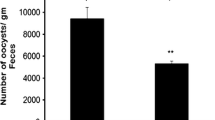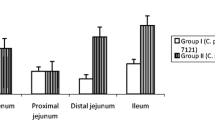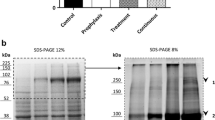Abstract
We investigated the immunomodulatory and parasiticidal effects of garlic extract on coccidiosis caused by Eimeria vermiformis infection in male ICR mice. One group received garlic extract daily until the end of the experiment by the oral route from 10 days prior to oral infection with 300 sporulated E. vermiformis oocysts (infected-garlic+). The other group served as a control positive with E. vermiformis infection alone (infected-garlic−). In the infected-garlic+ group, garlic extract treatment induced a significant reduction in fecal oocyst output when compared with the infected-garlic− group. Histopathological, immunohistochemical, and gene expression analysis for inflammatory cytokines in ileal tissues showed that the garlic extract treatment impaired intracellular development of E. vermiformis during the early stages by increasing the number of intraepithelial CD8+ T cells and decreasing IL-10 expression. This induced cell cytotoxicity which was reflected by a decrease in oocyst numbers in the intestinal villi and the feces, indicating anticoccidial effects of the garlic extract. However, further studies to explore the precise mechanism of the observed effects of garlic treatment during Eimeria infection are needed to verify our results.





Similar content being viewed by others
References
Ankri S, Mirelman D (1999) Antimicrobial properties of allicin from garlic. Microbes Infect 1(2):125–129
Ankri S, Miron T, Rabinkov A, Wilchek M, Mirelman D (1997) Allicin from garlic strongly inhibits cysteine proteinases and cytopathic effects of Entamoeba histolytica. Antimicrob Agents Chemother 41(10):2286–2288
Anthony JP, Fyfe L, Smith H (2005) Plant active components—a resource for antiparasitic agents? Trends Parasitol 21(10):462–468
Balasenthil S, Arivazhagan S, Ramachandran CR, Nagini S (1999) Effects of garlic on 7,12-dimethylbenz[a]anthracene-induced hamster buccal pouch carcinogenesis. Cancer Detect Prev 23(6):534–538
Bogdan C, Vodovotz Y, Nathan C (1991) Macrophage deactivation by interleukin 10. J Exp Med 174(6):1549–1555
Cao HX, Zhu KX, Fan JG, Qiao L (2014) Garlic-derived allyl sulfides in cancer therapy. Anti Cancer Agents Med Chem 14(6):793–799
Chapman HD (1997) Biochemical, genetic and applied aspects of drug resistance in Eimeria parasites of the fowl. Avian Pathol 26(2):221–244
Chien YH, Meyer C, Bonneville M (2014) γδ T cells: first line of defense and beyond. Annu Rev Immunol 32:121–155
Chung LY (2006) The antioxidant properties of garlic compounds: allyl cysteine, alliin, allicin, and allyl disulfide. J Med Food 9(2):205–213
Coppi A, Cabinian M, Mirelman D, Sinnis P (2006) Antimalarial activity of allicin, a biologically active compound from garlic cloves. Antimicrob Agents Chemother 50(5):1731–1737
Dommels YE, Butts CA, Zhu S, Davy M, Martell S, Hedderley D, Barnett MP, McNabb WC, Roy NC (2007) Characterization of intestinal inflammation and identification of related gene expression changes in mdr1a(−/−) mice. Genes Nutr 2(2):209–223
Feng Y, Zhu X, Wang Q, Jiang Y, Shang H, Cui L, Cao Y (2012) Allicin enhances host pro-inflammatory immune responses and protects against acute murine malaria infection. Malar J 11:268
Ford JT, Wong CW, Colditz IG (2001) Effects of dietary protein types on immune responses and levels of infection with Eimeria vermiformis in mice. Immunol Cell Biol 79(1):23–28
Gazzinelli RT, Oswald IP, James SL, Sher A (1992) IL-10 inhibits parasite killing and nitrogen oxide production by IFN-gamma-activated macrophages. J Immunol 148(6):1792–1796
Ghazanfari T, Hassan ZM, Ebtekar M, Ahmadiani A, Naderi G, Azar A (2000) Garlic induces a shift in cytokine pattern in Leishmania major-infected BALB/c mice. Scand J Immunol 52(5):491–495
Ghazanfari T, Hassan ZM, Khamesipour A (2006) Enhancement of peritoneal macrophage phagocytic activity against Leishmania major by garlic (Allium sativum) treatment. J Ethnopharmacol 103(3):333–337
Han J, Lawson L, Han G, Han P (1995) A spectrophotometric method for quantitative determination of allicin and total garlic thiosulfinates. Anal Biochem 225(1):157–160
Hershberg RM, Mayer LF (2000) Antigen processing and presentation by intestinal epithelial cells—polarity and complexity. Immunol Today 21(3):123–128
Ibarra-Velarde F, Alcala-Canto Y (2007) Downregulation of the goat beta-defensin-2 gene by IL-4 in caprine intestinal epithelial cells infected with Eimeria spp. Parasitol Res 101(3):613–618
Inagaki-Ohara K, Dewi FN, Hisaeda H, Smith AL, Jimi F, Miyahira M, Abdel-Aleem AS, Horii Y, Nawa Y (2006) Intestinal intraepithelial lymphocytes sustain the epithelial barrier function against Eimeria vermiformis infection. Infect Immun 74(9):5292–5301
Ishikawa H, Saeki T, Otani T, Suzuki T, Shimozuma K, Nishino H, Fukuda S, Morimoto K (2006) Aged garlic extract prevents a decline of NK cell number and activity in patients with advanced cancer. J Nutr 136(3 Suppl):816S–820S
Jenkins MC (2001) Advances and prospects for subunit vaccines against protozoa of veterinary importance. Vet Parasitol 101(3–4):291–310
Kidd P (2003) Th1/Th2 balance: the hypothesis, its limitations, and implications for health and disease. Altern Med Rev 8(3):223–246
Kondo M, Tamaoki J, Takeyama K, Nakata J, Nagai A (2002) Interleukin-13 induces goblet cell differentiation in primary cell culture from Guinea pig tracheal epithelium. Am J Respir Cell Mol Biol 27(5):536–541
Kyo E, Uda N, Kasuga S, Itakura Y (2001) Immunomodulatory effects of aged garlic extract. J Nutr 131(3s):1075S–1079S
Kyung KH (2012) Antimicrobial properties of allium species. Curr Opin Biotechnol 23(2):142–147
Linh BK, Hayashi T, Horii Y (2009) Eimeria vermiformis infection reduces goblet cells by multiplication in the crypt cells of the small intestine of C57BL/6 mice. Parasitol Res 104(4):789–794
Lun ZR, Burri C, Menzinger M, Kaminsky R (1994) Antiparasitic activity of diallyl trisulfide (Dasuansu) on human and animal pathogenic protozoa (Trypanosoma sp., Entamoeba histolytica and Giardia lamblia) in vitro. Ann Soc Belg Med Trop 74(1):51–59
Mantawy MM, Ali HF, Rizk MZ (2011) Therapeutic effects of Allium sativum and Allium cepa in Schistosoma mansoni experimental infection. Rev Inst Med Trop Sao Paulo 53(3):155–163
Metwaly MS, Dkhil MA, Al-Quraishy S (2012) The potential role of Phoenix dactylifera on Eimeria papillata-induced infection in mice. Parasitol Res 111(2):681–687
Rose ME, Owen DG, Hesketh P (1984) Susceptibility to coccidiosis: effect of strain of mouse on reproduction of Eimeria vermiformis. Parasitology 88(Pt 1):45–54
Rose ME, Hesketh P, Wakelin D (1992) Immune control of murine coccidiosis: CD4+ and CD8+ T lymphocytes contribute differentially in resistance to primary and secondary infections. Parasitology 105(Pt 3):349–354
Rothwell L, Young JR, Zoorob R, Whittaker CA, Hesketh P, Archer A, Smith AL, Kaiser P (2004) Cloning and characterization of chicken IL-10 and its role in the immune response to Eimeria maxima. J Immunol 173(4):2675–2682
Schmittgen TD, Livak KJ (2008) Analyzing real-time PCR data by the comparative C(T) method. Nat Protoc 3(6):1101–1108
Shadkchan Y, Shemesh E, Mirelman D, Miron T, Rabinkov A, Wilchek M, Osherov N (2004) Efficacy of allicin, the reactive molecule of garlic, in inhibiting Aspergillus spp. in vitro, and in a murine model of disseminated aspergillosis. J Antimicrob Chemother 53(5):832–836
Shibata Y, Foster LA, Kurimoto M, Okamura H, Nakamura RM, Kawajiri K, Justice JP, Van Scott MR, Myrvik QN, Metzger WJ (1998) Immunoregulatory roles of IL-10 in innate immunity: IL-10 inhibits macrophage production of IFN-gamma-inducing factors but enhances NK cell production of IFN-gamma. J Immunol 161(8):4283–4288
Shields JM, Olson BH (2003) Cyclospora cayetanensis: a review of an emerging parasitic coccidian. Int J Parasitol 33(4):371–391
Smith AL, Hayday AC (1998) Genetic analysis of the essential components of the immunoprotective response to infection with Eimeria vermiformis. Int J Parasitol 28(7):1061–1069
Soffar SA, Mokhtar GM (1991) Evaluation of the antiparasitic effect of aqueous garlic (Allium sativum) extract in hymenolepiasis nana and giardiasis. J Egypt Soc Parasitol 21(2):497–502
Waag T, Gelhaus C, Rath J, Stich A, Leippe M, Schirmeister T (2010) Allicin and derivates are cysteine protease inhibitors with antiparasitic activity. Bioorg Med Chem Lett 20(18):5541–5543
Wabwoba BW, Anjili CO, Ngeiywa MM, Ngure PK, Kigondu EM, Ingonga J, Makwali J (2010) Experimental chemotherapy with Allium sativum (Liliaceae) methanolic extract in rodents infected with Leishmania major and Leishmania donovani. J Vector Borne Dis 47(3):160–167
Williams RB (1999) A compartmentalised model for the estimation of the cost of coccidiosis to the world’s chicken production industry. Int J Parasitol 29(8):1209–1229
Yasuda M, Taura Y, Yokomizo Y, Ekino S (1998) A comparative study of germinal center: fowls and mammals. Comp Immunol Microbiol Infect Dis 21(3):179–189
Yun CH, Estrada A, Van Kessel A, Park BC, Laarveld B (2003) Beta-glucan, extracted from oat, enhances disease resistance against bacterial and parasitic infections. FEMS Immunol Med Microbiol 35(1):67–75
Acknowledgments
One of the authors, A.M. Khalil, received financial support from the Egyptian government for Channel System Program towards a PhD. This work was supported by the Project for Zoonoses Education and Research, University of Miyazaki, Japan.
Author information
Authors and Affiliations
Corresponding author
Rights and permissions
About this article
Cite this article
Khalil, A.M., Yasuda, M., Farid, A.S. et al. Immunomodulatory and antiparasitic effects of garlic extract on Eimeria vermiformis-infected mice. Parasitol Res 114, 2735–2742 (2015). https://doi.org/10.1007/s00436-015-4480-5
Received:
Accepted:
Published:
Issue Date:
DOI: https://doi.org/10.1007/s00436-015-4480-5




